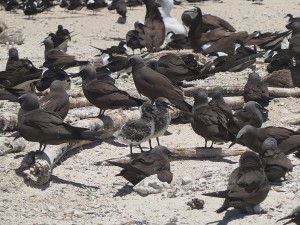Quick, name 10 animals that live in the Great Barrier Reef—I’ll give you a minute.
Done?
How many could you get? Seaturtles, check. Nemo, check. Jellyfish, butterfly fish, check, check. Parrotfish, Maori wrasse, whitetip reef shark, blacktip reefshark, check, check, check, and check. Stingray, Moray eel, check, and check. Great, you got ten. However, did you name any animals *not* living in the water?
Little known fact: The Great Barrier Reef, one of the most complex ecosystems on the planet, has over 215 species of sea birds that either live there full time or transit through during migrations. White-bellied sea eagles, little terns, brown boobies ,frigate birds, lesser frigate birds, ruddy turnstones, silver gulls, bridled terns, black-naped terns, reef herons, roseate terns… the list is big. A handful of these bird species, approximately 17, can be found at Michaelmas Cay, one of Passions of Paradise’s stops on your reef adventure.
Michaelmas Cay is important as a breeding site for several species of terns. It has been identified by BirdLife International as an Important Bird Area (IBA) because it supports over 1% of the world populations of Greater and Lesser Crested Terns. Sooty Terns and Common Noddies also breed there, as well as Brown Boobies. Many different species of birds nest at the Cay year-round, and all have very specific breedingand nesting habits. Brown boobies nest in large colonies, laying two chalky blue eggs on the ground in a mound of broken shells and vegetation, and generally stay near dry land; sooty terns rarely come to land except to breed, and can stay out to sea (either soaring or floating on the water) for 3 to 10 years, and will nest in a ground scrape or hole and lay one to three eggs when they do come in to breed. Similarly, Frigatebirds will not breed every year, and will generally only lay one egg at a time, which both parents will care for in the first three months, with the mother feeding them for an additional eight months.
As the weather starts to warm in early November, visitors aboard Passions of Paradise can expect to see Brown Boobies and Common Noddies nesting in and around Michaelmas Cay. Brown Boobies, which are a common sight at the Cay, can be seen nesting year round, with chicks usually hatching in mid-November. These birds are generally tolerant of bird watchers, providing there is no encroachment near the nest or chicks. The truly spectacular sight to see, starting around November, is when the Common Noddies come from hundreds, sometimes thousands of kilometres, to breed on Michaelmas Cay. Usually preferring to stay out to sea, the Common Noddies will breed in colonies which may contain over 100,000 nests, and Michaelmas Cay is no exception; population estimates from Queensland Parks and Wildlife Service performed during breeding season calculate an average of 20,000 breeding pairs—about 40,000 individuals—on the cay during mating season. Indeed, as the weather turns warm and the winds die down, now is the perfect time to come to the Cay and witness the mass nesting of the various species, especially the Brown Boobies and Common Noddies.
Sea birds are a vital part of the marine ecosystem. Their droppings, or guano, help fertilise and cement the sand on sand cays such as Michaelmas Cay, and they are an important food source for many types of shark, such as the Tiger shark. Surprisingly, many visitors to the reef, in particular Michaelmas cay, have no plans on even entering the water; instead of a mask and set of fins, they bring binoculars and long-lens cameras, hoping to catch a glimpse of chicks, eggs, or parents looking after their young. If you are one of these bird aficionados, we welcome you out for a day on Passions of Paradise. Let our friendly staff direct you as to the access areas on the Cay, so that you can minimise your impact on the nesting sea birds.
Remember: We have one reef. Let’s take care of it!
Images Courtsey of Passions of Paradise and Christian Miller



